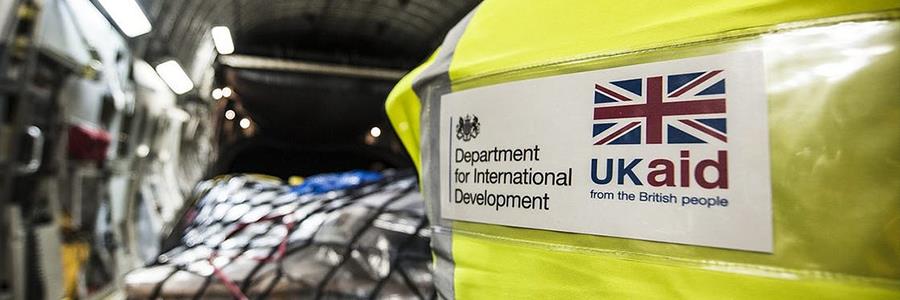The proportion of Britain’s £13.4bn aid budget spent by government ministries other than the Department for International Development rose by almost 50% last year, sparking concerns about transparency and poverty reduction.
Roughly a quarter of the aid budget, which met the 0.7% target set by the government, was spent by non-DfID departments, official figures show. Aid organisations criticised the government’s increasing tendency to channel aid though non-DfID departments as “out of step with transparency and the focus on the poorest countries”.
According to DfID’s final spend statistics, 73.8% of UK overseas development assistance went through the department in 2016, with 18.3% directed through other government departments and 2.4% through other contributors. The amount of aid spent outside DfID has risen dramatically – by almost 200% – since 2012.

A DfID official looks on as UK aid supplies are unloaded from a plane in Kathmandu.
Earlier this year, a report by the Institute for Fiscal Studies warned that the trend towards funnelling less aid money through DfID, combined with a growing emphasis on ensuring benefit to British firms, could have a negative impact on poverty reduction in developing countries.
In July, the National Audit Office warned that overseas aid spending needed closer scrutiny, particularly by departments other than DfID. Gideon Rabinowitz, policy manager at Oxfam, said the 2016 figures raised serious questions about the government’s commitment to helping the world’s poorest people.
“It is a question of the extent to which these departments are focused on the people most in need,” said Rabinowitz. “The fact they are spending more on low- and upper-middle income countries than in least developed countries raises serious questions.”
The figures, published by DfID on Thursday, showed that only about a quarter of non-DfID bilateral aid money went to the least developed countries in 2016. About 74% of it went to low- and upper-middle income countries.
Rabinowitz said: “The trend of increasing aid through other government departments seems to be out of step with transparency and the focus on the poorest countries. We want to see these other departments upping their game in order to justify their aid spending, and to match the transparency and poverty focus of DfiD in order to justify that spend.”
He also expressed concern about a fall in health spending.
Sonya Krutikova, of the Institute for Fiscal Studies, said the rise in aid spend through departments other than DfID “seems to be in line with the direction of travel”.
“There are two issues,” she said. “We are one of the very few countries meeting the 0.7% target at a time when the majority of the UK government departments have been cut.
“DfID has a commitment enshrined in UK law to reducing poverty. It is not very clear that the other departments have that same commitment. Many have questioned whether the national interest and poverty reduction are compatible or complementary goals.
“The other issue is about transparency. What is it we are committed to? Do we want a 0.5% target, but in a way that we haven’t made explicit?”
DfID’s budget increased by 24% between 2010-11 and 2015-16, while the average cut for departments outside the National Health Service, education and defence was 28%.
Neil Thorns, director of advocacy at Cafod, said he was concerned about whether other departments’ aid spending received the same level of scrutiny as DfId. He said:
“DFID has very high levels of transparency and accountability that we think should be the norm for all government aid spending, to make sure it’s effective, well-targeted and its top priority remains reaching the world’s poorest people.”
Non-DfID aid spending was carried out largely by the Department for Business, Energy and Industrial Strategy, the conflict, stability and security fund, the Foreign and Commonwealth Office, and the Home Office.
The top three recipients of UK bilateral overseas development assistance were Pakistan at £463m , Syria (£352m) and Ethiopia (£334m).
The highest drop in spending was to India, which fell from being the ninth biggest recipient of UK aid in 2015 to 23rd place in 2016. Spending in health education and government sectors in India fell by more than half, reflecting the government’s policy to end traditional financial aid to India and move to aid partnership based on private sector investment.
Original source: The Guardian
Published on 16 November 2017

